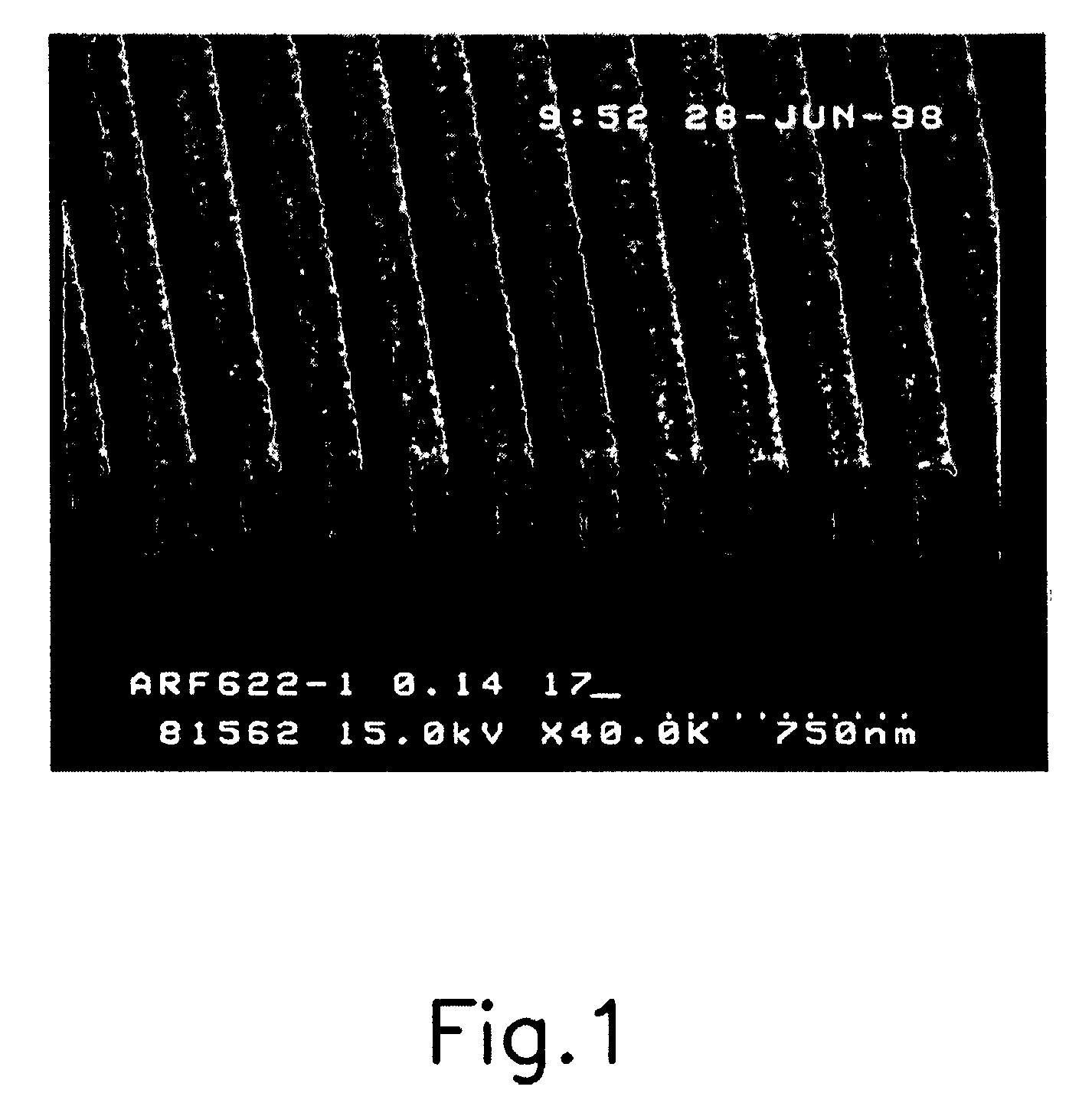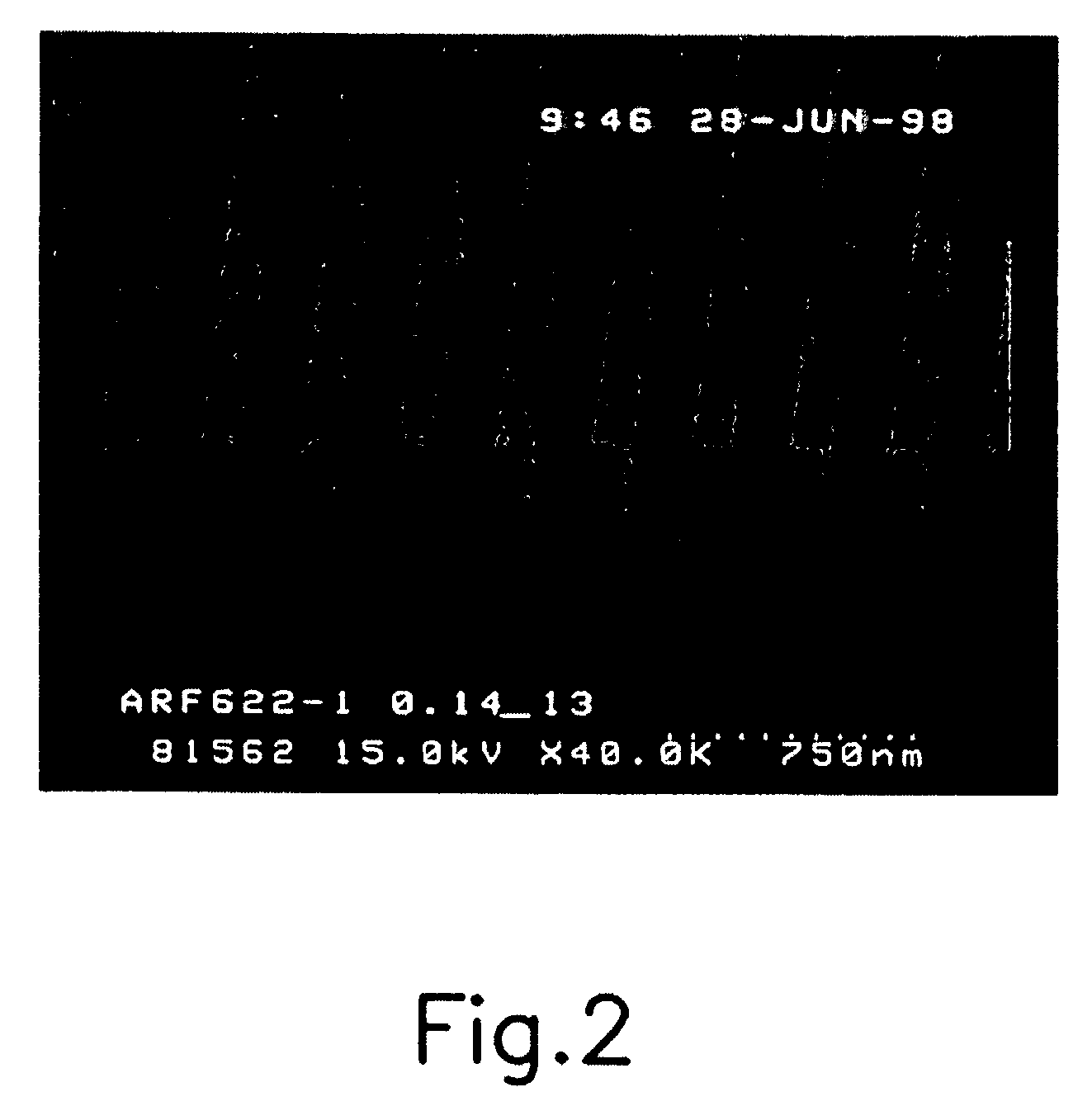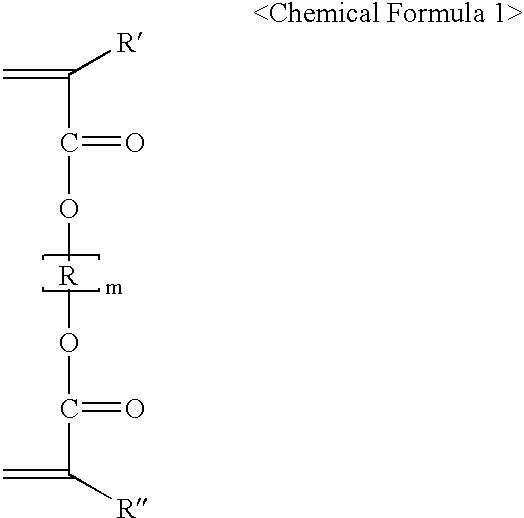Cross-linking monomers for photoresist, and process for preparing photoresist polymers using the same
a technology of cross-linking monomers and photoresist polymers, which is applied in the field of cross-linking monomers for photoresist polymers and the process of preparing photoresist polymers, to achieve the effect of improving the polymerization yield of photoresist polymers
- Summary
- Abstract
- Description
- Claims
- Application Information
AI Technical Summary
Benefits of technology
Problems solved by technology
Method used
Image
Examples
example 1
Synthesis of poly(maleic anhydride / 2-hydroxyethyl 5-norbornene-2-carboxylate / tert-butyl 5-norbornene-2-carboxylate / 5-norbornene-2-carboxylic acid / 1,3-butanediol diacrylate)
[0039]First, (i) 2-hydroxyethyl 5-norbornene-2-carboxylate (0.1 mole), (ii) tert-butyl 5-norbornene-2-carboxylate (0.85 mole), (iii) 5-norbornene-2-carboxylic acid (0.05 mole), (iv) 1,3-butanediol diacrylate (0.1 mole), which is a cross-linking monomer within the scope of Chemical Formula 2, and (v) maleic anhydride (1.0 mole) are dissolved in tetrahydrofuran.
[0040]2,2′-Azobisisobutyronitrile (AIBN) (6.16 g) is added to the resultant solution as a polymerization initiator, and the mixture is reacted at 67° C. for 10 hours under an atmosphere of nitrogen or argon. The polymer thus obtained is precipitated from ethyl ether or hexane, and dried to obtain poly(maleic anhydride / 2-hydroxyethyl 5-norbornene-2-carboxylate / tert-butyl 5-norbornene-2-carboxylate / 5-norbornene-2-carboxylic acid / 1,3-butanediol diacrylate) of fo...
example 2
Synthesis of poly(maleic an hydride / 2-hydroxyethyl 5-norbornene-2-carboxylate / tert-butyl 5-norbornene-2-carboxylate / 5-norbornene-2-carboxylic acid / 1,4-butanediol diacrylate)
[0042]The procedure of Example 1 is repeated but using 1,4-butanediol diacrylate instead of 1,3-butanediol diacrylate, to obtain poly (maleic anhydride / 2-hydroxyethyl 5-norbornene-2-carboxylate / tert-butyl 5-norbornene-2-carboxylate / 5-norbornene-2-carboxylic acid / 1,4-butanediol diacrylate) of following Chemical Formula 7:
[0043]
The molar ratio a1:a2:a3:b:c is 0.405:0.048:0.024:0.476:0.047.
example 3
[0044]After dissolving the photoresist polymer of Chemical Formula 6, obtained from Example 1 (3.57 g), in ethyl 3-ethoxypropionate (25 g), triphenylsulfonium triflate (0.02 g) is added as a photoacid generator, and the resultant mixture is filtered through a 0.10 μm filter to prepare a photoresist composition.
[0045]The photoresist composition thus prepared is spin-coated on a silicon wafer, and soft-baked at 110° C. for 90 seconds. Then, after irradiating with light having exposure energy of 0.1 to 40 mJ / cm2 using an ArF laser exposer, the wafer is post-baked again at 110° C. for 90 seconds. When the post-baking is completed, it was developed in 2.38 wt % aqueous TMAH solution for 40 seconds, to obtain 0.14 μm L / S pattern (FIG. 1).
PUM
| Property | Measurement | Unit |
|---|---|---|
| Temperature | aaaaa | aaaaa |
| Temperature | aaaaa | aaaaa |
| Temperature | aaaaa | aaaaa |
Abstract
Description
Claims
Application Information
 Login to View More
Login to View More - R&D
- Intellectual Property
- Life Sciences
- Materials
- Tech Scout
- Unparalleled Data Quality
- Higher Quality Content
- 60% Fewer Hallucinations
Browse by: Latest US Patents, China's latest patents, Technical Efficacy Thesaurus, Application Domain, Technology Topic, Popular Technical Reports.
© 2025 PatSnap. All rights reserved.Legal|Privacy policy|Modern Slavery Act Transparency Statement|Sitemap|About US| Contact US: help@patsnap.com



